物流英语chapter 2 Purchasing
- 格式:ppt
- 大小:153.00 KB
- 文档页数:44
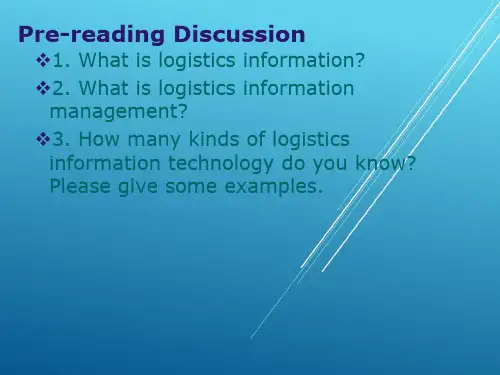
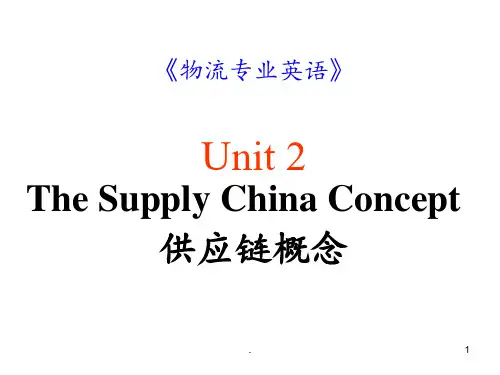


物流英语名词解释(总5页)--本页仅作为文档封面,使用时请直接删除即可----内页可以根据需求调整合适字体及大小--1.purchasing 采购Purchasing refers to a function in business where by the enterprise obtains the inputs for what it produces, as well as other goods and services it requires.2.efficiency 效率,功效Efficiency refers to the state or quality of being efficient.3.bonded warehouse 保税仓库A bonded warehouse is a warehouse in which goods are stored without excise or customs duties being paid until and unless they are removed from the warehouse to enter the country.4.customer service 客户服务Customer service is the set of behaviors that a business undertakes during its interaction with its customers.5.consistency 一致性Consistency refers to a firm’s ability to perform at the expected delivery time over a large number of performance cycles.6.convenience products 便利型产品Convenience products are those goods and services that customers purchase frequently, immediately, and with little comparative shopping.7.zero inventory 零库存Zero inventories is a term used to describe a Just -In –Time Inventory Control system where emphasis is placed on reducing inventory to minimal levels to reduce costs and promote organizational effectiveness. This can result in sizable profit increase.8.variable costs 可变成本They are those costs that change in a predictable, direct manner in relation to some level of activity during a time period.9.obsolescence 损耗Obsolescence means the deterioration of product in storage which is not covered by insurance. 10.lot quantity formulation 批量公式Lot quantity formulations identify the precise quantities at which the annual combined total cost of ordering and maintenance is lowest for a given sales volume.11.consumer packaging 消费性包装Consumer packaging mainly aims at containing the goods, promoting the sale of it and facilitating use of it and it is of little value to logistics operation.12.franchise 专营权It is the formal permission to sell a company’s goods or services in a particular area.13.supply chain management 供应链管理Supply chain management is managing the flow of materials across the supply chain, from preparing the raw materials to supplying the finished product to the customer, as well as the related counterblow of information, regarding controlling and recording of materials movement.14.First Mate 大副An officer who has the rank just below captain on a ship that is not a military ship.15.Bill of Lading 提单A receipt given by the carrier to the shipper acknowledging receipt of the goods being shipped and specifying the terms of delivery.16.supply chain management 供应链管理Supply chain management is the process that integrates coordinates and controls the movements of materials, finished inventory and related information from suppliers through companies to meet consumer requirements.17.Third-Party Logistics 第三方物流A third party logistics provider (abbreviated TPL) is a firm that provides outsourced or “third party”logistics services to companies for part or cometimes all of their supply chain management function.18.unitization 单元化to combine a number of packages into one unit by straping, banding ,shrinking, wrapping or otherwise attaching them together.19.logistics 物流Logistics is that part of supply chain process that plans, implements and controls the efficient, effective flow and storage of goods, service and related information from the point of origin to the point of consumption to meet ustomers’ requirements.20.Third-Party Logistics provider 第三方物流供应商TPL provider is the company offering customs a beginning -to- end include supply chaina manangement, including contracted logistics, freignt forwarding, warehousing, transportation and distribution, a wide ragne of information technology systems and other value-services and customized solutions.21.shopping products 购买型产品Shopping products are those for which consumers are willing to seek and compare: comparing in many locations, the price, quality, and performance, and making a purchase only after careful deliberation.22.logistics 物流Logistics is a part of the supply chain process that plans, implements and controls the efficient, effective flow and storage of goods, service and related information from the point of origin to the point of consumption to meet customers’ requirements.23.supply chain management 供应链管理Supply chain management means the process that integrates co-ordinates and controls the movement of materials, finished inventory and related information from suppliers through companies to meet consumer requirements.24.obsolescence 损耗Obsolescence means the deterioration of product in storage which is not covered by insurance. 25.availability 可用性Availability is the capacity to have inventory when it is desired by a customer.26.convenience products 便利型产品Convenience products are those goods and services that consumers purchase frequently, immediately, and with little comparative shopping.27.consistency 一致性Consistency refers to a firm’s ability to perform at the expected delivery time over a large number of performance cycles.28.variable costs 可变成本Variable costs are those costs that change in a predictable, direct manner in relation to some level of activity during a time period.29.specialty products 特殊产品Specialty products are those for which buyers are willing to expend a substantial effort and often to wait a significant amount of time in order to acquire them.30.external supply chains 外部供应链External supply chains are the processes where internal supply chains can be extended to the total network where an organization finds itself in.31.customer service 客户服务Customer service is a process of providing significant value-added benefits to the supply chain in a cost-effective way.32.operational flexibility 业务灵活性Operational flexibility refers to a firm’s ability to handle extraordinary customer service requests.33.demand forecasting 需求预测Demand forecasting addresses the need for accurate information on future customer needs so that the logistics system can ensure the right products and services are available to meet those requirements.34.inventory 库存Inventory is a detailed list of all the items in stock, such as a company’s merchandise, raw materials, and finished and unfinished products which have not yet been sold.35.strategic planning 战略规划Strategic planning is planning which focuses on longer range objectives and goals. It is essentially direction-setting and often focuses on new products and new markets.36.supply chain 供应链Supply chain is defined as a network composed of factories, suppliers, retailers, etc. that supply to each other raw material, components, products and service.37.Bill of Lading 提单Bill of lading is a receipt for goods shipped; stating the terms of the contract of carriage, which it may do in part by words incorporating clauses from a charter party.38.shipping agent 货运代理Shipping agent: a ship owner’s representative whose job is to find cargoes for the ships to carry.39.documentation 文件、文档资料Documentation: the documents involved in import/export, such as invoices, insurance policies or insurance certificates, bill of lading, drafts, etc.40.insurance policy 保险政策Insurance policy: a written document between an insured person and an insurance company specifying the exact losses to be covered and the costs to the insured person.41.Mate’s Receipt 大副收据Mate’s Receipt, in cases where given, is an intermediate document to be given up by the shipper in exchange for Bill of Lading.42.JIT 准时制The ideal is to have needed materials arrive just at the moment they are scheduled to be used in the production process, in other words, just in time.43.Tariff 关税Duty or tax levied on a specific commodity when it crosses national boundaries.44.warehousing 仓储Warehousing is sometime needed, and can be provided, to complement inbound and outbound transportation services.45.packaging 包装Packaging is the outer wrapping of a product.46.transport 运输Transport is the movement of people, goods, signals and information from one place to another.47.Letter of Credit 信用证Letter of Credit is a letter from a bank to a foreign bank authorizing the payment of a specified sum to the person or company named.48.Customs Clearance 海关清关,报关Customs clearance refers to the document given by customs to a shipper to show that customs duty has been paid and the goods can be shipped.49.procurement 采购Procurement is concerned with purchasing and arranging inbound movement of materials, parts and finished inventory from suppliers to manufacturing of assembly plants, warehouses or retail stores.。
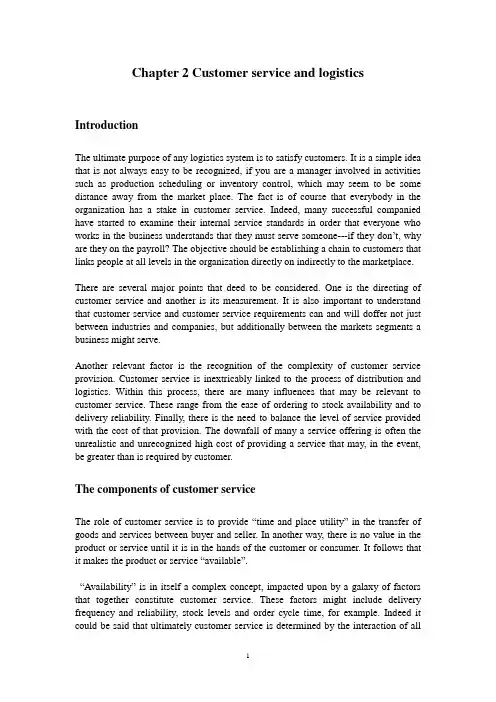
Chapter 2 Customer service and logistics IntroductionThe ultimate purpose of any logistics system is to satisfy customers. It is a simple idea that is not always easy to be recognized, if you are a manager involved in activities such as production scheduling or inventory control, which may seem to be some distance away from the market place. The fact is of course that everybody in the organization has a stake in customer service. Indeed, many successful companied have started to examine their internal service standards in order that everyone who works in the business understands that they must serve someone---if they don’t, why are they on the payroll? The objective should be establishing a chain to customers that links people at all levels in the organization directly on indirectly to the marketplace.There are several major points that deed to be considered. One is the directing of customer service and another is its measurement. It is also important to understand that customer service and customer service requirements can and will doffer not just between industries and companies, but additionally between the markets segments a business might serve.Another relevant factor is the recognition of the complexity of customer service provision. Customer service is inextricably linked to the process of distribution and logistics. Within this process, there are many influences that may be relevant to customer service. These range from the ease of ordering to stock availability and to delivery reliability. Finally, there is the need to balance the level of service provided with the cost of that provision. The downfall of many a service offering is often the unrealistic and unrecognized high cost of providing a service that may, in the event, be greater than is required by customer.The components of customer serviceThe role of customer service is to provide “time and place utility” in the transfer of goods and services between buyer and seller. In another way, there is no value in the product or service until it is in the hands of the customer or consumer. It follows that it makes the product or service “available”.“Availability” is in itself a complex concept, impacted upon by a galaxy of factors that together constitute customer service. These factors might include delivery frequency and reliability, stock levels and order cycle time, for example. Indeed it could be said that ultimately customer service is determined by the interaction of allthose factors that affect the process of making products and services available to buyer.In practice, we see that many companies have varied views of customer service. LaLonde and Diffuser in a major study of customer service practices suggested that customer service could be examined fewer than three headings:1. Pre-transaction elements: these are customer service factors that arise prior to the actual transaction taking place.2. Transaction elements: these are the elements directly related to the physical transaction and are those that are most commonly concerned with distribution and logistics.3. Post-transaction elements: these involve those elements that occur after the delivery had taken place.Table 1 indicates some of the many elements of customer service under these three healings.Table 1 the components of customer servicePre-transaction elementsFor example:●Written customer service policy(Is it communicated internally and externally, is it understood, is it specific and quantified where possible?)●Accessibility(Are we easy tab contact/do business with? It there a single point of contact?)●Organization structure(Is there a customer service management structure in place? What level of control do they have over their service process?)●System flexibility(Can we adapt our service delivery systems to meet particular customer needs)Transaction elementsFor example:●Order cycle time(What is the elapsed time from order to delivery? What is the reliability/variation?)●Inventory availability(What percentage of demand for each item can be met from stock?)●Order fill rate(What proportions of order are completely filled within the stated lead-time?)●Order status information(How long does it take us to respond to a query with the required information? Do we inform the customer of problems or do they contact us?)Post-transaction elementsFor example:●Availability of spares(What are the in-stock levels of service parts?)●Call-out time(How long does it take for the engineer to arrive and what is the “first call fix rate”?)●Product tracing/warranty(Can we identify the location of individual products? Can we maintain/extend the warranty to customers’ expected level?)●Customer complains, claims etc(How promptly do we deal with complaints and returns? Own measure customer satisfaction with our response?)Customer service policyThe fact that there are so many different elements of customer service as indicated in the previous section underlines the need for a company to have a clearly defined customer service policy. Also, there are many different types of customer even for the same product. A can of cola, for example, may be bought in a supermarket, a corner shop, a petrol station or from a self-service dispensing unit. It us unlikely that a manufacturer of cola would wish to provide exactly the same level and style to service to all of these very different customer types---an additional argument for the need for a clearly customer service policy.Many studied have been undertaken to measure the effects of poor customer service. These studies conclude, quite categorically, that where stock is not available or where delivery in unreliable, many buyers will readily turn to an alternative supplier’s product to fulfill their requirements.Once the positive need for a customer service policy has been recognized and accepted, it is necessary to determine the basic requirements and format of this policy. These might include:●An understanding of the different market segments that exist;●An awareness of the customers needs or perceived needs within the segmentation;●The determination of clearly defined and quantifiable standards of customerservice in relation to the different market segments;●An understanding of the trade-off between the costs and levels of customerservice;●Measurement of the service provided; and●Liaison with customers to ensure an understanding and appreciation of the serviceprovided.It is also important to understand what minimum requirements are necessary when identifying any particular service policy. A suppler is really working towards meeting customers’ minimum requirements to cross the threshold of customer satisfaction. If these minimum requirements are not met, the supplier cannot even expect to be considered as a feasible supplier. Once there requirements are met and the supplier begins to exceed them, it then becomes possible to achieve customer satisfaction and begin to add value to the supply relationship.The next stage is to set about defining this customer service policy. In the following section such an approach is described.It is possible to develop a logical approach to facilitate the establishment of a suitable customer service policy. One such approach is shown in Figure 1. This is a six-step plan to identify key customer service components and then to design a suitable customer service package.Levels of customer serviceIt has already been stressed that there is a need to balance the level of customer service with the cost of providing that service. This balance is not easy to define although it can be described quite easily as the point where the additional revenue for each increment of service is equal to the extra cost of providing that increment.It is seldom possible to devise a policy that is absolutely optimal in terms of thecost/service balance. Some companies adopt a cost minimization approach where specific service objectives are laid down and met at a minimum cost. Others choose service maximization approach where a distribution budget is fixed, and the “best ” service supplied with this cost constraint. The most appropriate approach to adopt will depend on particular product, business or market segments.One factor that is clear, however, is the relationship between cost and service. This is shown if figure2. The cost of providing a given service is markedly higher the nearer it reaches the “perfect service ”, that is, the 100 percent mark. Thus, an increase of 2 percent in service levels will cost far more between 95 and 97 percent than between 70 and 72 percents. It should also be noted that a service increase from, say, 95 to 97 percent may well have little, if any, noticeable impact on the customer ’s perception of the service being provided, even though it is a costly improvement.Figure 2 Relationship between cost and service levelMeasuring customer serviceIt is probably quite clear from reading this chapter that there are many differentmeasures of customer service that might be used. The most important message is that 70 80 90 100Level of service (%) Cost of servicewhatever measures are used, they must reflect the key service requirements for the customer in question. This is mot always as obvious as it might seem. One particular example is that of order fulfillment. It is possible to measure this in a number of different ways:●The number of orders completely satisfied, say 18 out of 20, over a period (90%);●The number of lines delivered from a single order, say 75 out of the 80 linesrequested (94%)●The number of line items or cases delivered from a single order; say 75 out of the80 lines requested, but only 1,400 of the 1,800 total line items (78%)●The value of the order completed,.Any or all of these might be used and there is no right or wrong one. The most appropriated is the one that best suits the operation in question. As will be shown later, it may also be relevant to use a combination of these measures.There are other measures that can be made. These measures might, for example, be aimed at assessing the timeliness of delivery operations. Many express parcels companies set great store by the speed of their delivery operations, and calculate in detail the time taken from receipt of order or parcel collection to final delivery. This idea is also used for conventional operations. Thus, order fulfillment can also be measured with respect to the order cycle time or the actual lead-time from the receipt of the order to its final delivery to the customer. For a typical stock order this will be made up of the following discrete times:●Order receipt to order entry;●Order entry to allocation for picking;●Allocation to dispatch;●Dispatch to delivery.Some companies now recognize what is known as “the perfect order”. This is a measure that attempts to take in account all of these main attributes that go towards the completion of an order that absolutely satisfies customer requirements. This is knows as “on time in full” or OTIF. The key components are:●Delivered complete to the quantities ordered;●Delivered exactly to the customers requested date and times;●No delivery problems (damage, shortage, refusal);●Accurate and complete delivery documentation.SummaryThis chapter has considered some of the key aspects of customer service and logistics. The major components of customer service were described. They sere summarized as: Pre-transaction elements; Transaction elements; Post-transaction elements. The needfor an appreciate customer service police was emphasized. An approach for developing such a policy was outlined. The importance of accurate customer service measurements was explained. Different measures of order fulfillment were described. Achieving appropriate and effective customer service has become a critical factor for success for most companies operating in today’s competitive environment. This chapter has considered some of the key requirements for successful customer service in logistics.。
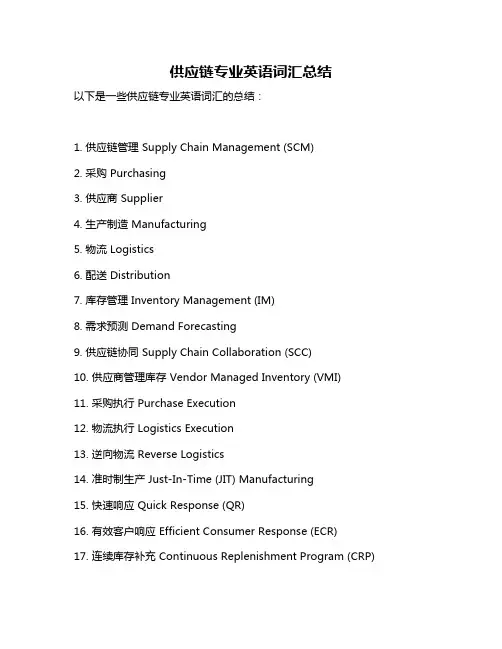
供应链专业英语词汇总结以下是一些供应链专业英语词汇的总结:1. 供应链管理 Supply Chain Management (SCM)2. 采购 Purchasing3. 供应商 Supplier4. 生产制造 Manufacturing5. 物流 Logistics6. 配送 Distribution7. 库存管理 Inventory Management (IM)8. 需求预测 Demand Forecasting9. 供应链协同 Supply Chain Collaboration (SCC)10. 供应商管理库存 Vendor Managed Inventory (VMI)11. 采购执行 Purchase Execution12. 物流执行 Logistics Execution13. 逆向物流 Reverse Logistics14. 准时制生产 Just-In-Time (JIT) Manufacturing15. 快速响应 Quick Response (QR)16. 有效客户响应 Efficient Consumer Response (ECR)17. 连续库存补充 Continuous Replenishment Program (CRP)18. 电子数据交换 Electronic Data Interchange (EDI)19. 全球定位系统 Global Positioning System (GPS)20. 射频识别技术 Radio Frequency Identification (RFID)21. 自动化仓库 Automated Warehouse22. 高级计划与排程 Advanced Planning and Scheduling (APS)23. 企业资源规划 Enterprise Resource Planning (ERP)24. 客户关系管理 Customer Relationship Management (CRM)25. 电子采购 e-Procurement26. 供应链风险管理 Supply Chain Risk Management (SCRM)27. 精益供应链管理 Lean Supply Chain Management (LSCM)28. 环境可持续供应链管理 Environmentally Sustainable Supply Chain Management (ESSCM)29. 社会可持续供应链管理 Socially Sustainable Supply Chain Management (SSSCM)30. 可持续供应链管理 Sustainable Supply Chain Management (SSCM)31. 供应商评价 Supplier Evaluation32. 采购谈判 Purchasing Negotiation33. 供应链绩效评估 Supply Chain Performance Evaluation (SCPE)34. 总成本分析 Total Cost Analysis (TCA)35. 总持有成本 Total Cost of Ownership (TCO)36. 经济订货量模型 Economic Order Quantity Model (EOQ)37. 安全库存 Safety Stock38. 采购周期 Purchasing Cycle39. 供应链网络 Supply Chain Network40. 多供应商 Multi-supplier41. 多配送中心 Multi-distribution Center42. 库存周转率 Inventory Turnover Rate43. 在途库存 In-transit Inventory44. 在途货物 In-transit Cargo45. 在途车辆 In-transit Vehicle46. 在途订单 In-transit Order47. 在途发票 In-transit Invoice。
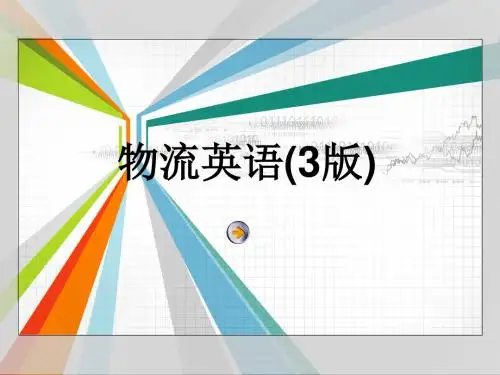
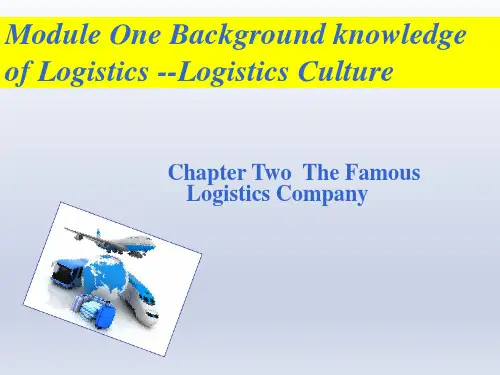
![物流英语(第二篇第三单元)[15页]](https://uimg.taocdn.com/7b5bc7c54431b90d6d85c713.webp)
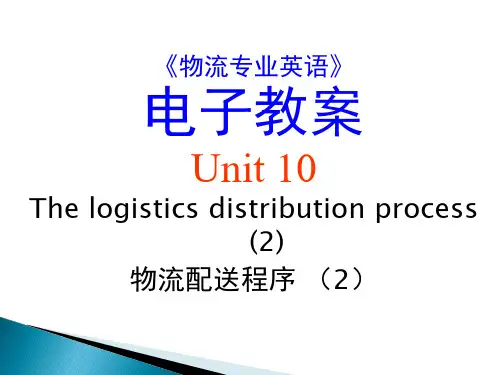
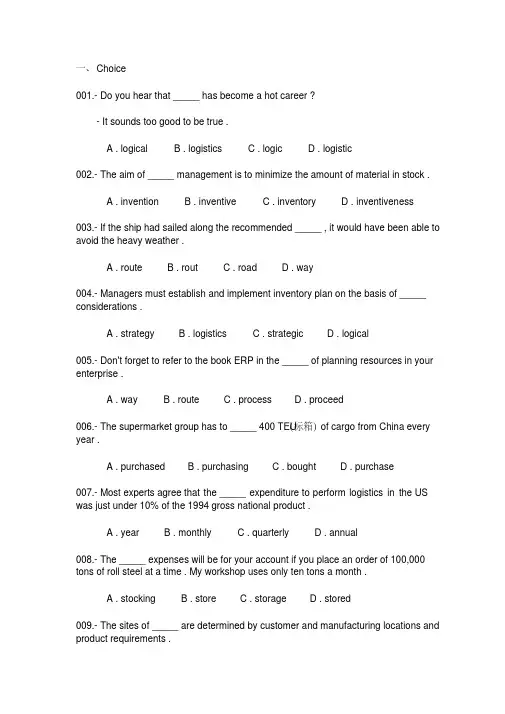
一、Choice001.- Do you hear that _____ has become a hot career ?- It sounds too good to be true .A . logicalB . logisticsC . logicD . logistic002.- The aim of _____ management is to minimize the amount of material in stock .A . inventionB . inventiveC . inventoryD . inventiveness003.- If the ship had sailed along the recommended _____ , it would have been able to avoid the heavy weather .A . routeB . routC . roadD . way004.- Managers must establish and implement inventory plan on the basis of _____ considerations .A . strategyB . logisticsC . strategicD . logical005.- Don't forget to refer to the book ERP in the _____ of planning resources in your enterprise .A . wayB . routeC . processD . proceed(标箱)of cargo from China every 006.- The supermarket group has to _____ 400 TEUyear .A . purchasedB . purchasingC . boughtD . purchase007.- Most experts agree that the _____ expenditure to perform logistics in the US was just under 10% of the 1994 gross national product .A . yearB . monthlyC . quarterlyD . annual008.- The _____ expenses will be for your account if you place an order of 100,000 tons of roll steel at a time . My workshop uses only ten tons a month .A . stockingB . storeC . storageD . stored009.- The sites of _____ are determined by customer and manufacturing locations and product requirements .A . houseB . warehouseC . factoryD . storage010.- The chapter describes reactive methods , which respond to product demand at individual _____ .A . placeB . siteC . positionD . location011.- It is through the logistical process that _____ are distributed through marketing channels to consumers .A . productB . productsC . itemD . cargo012.- The big city has a multi-cultural population with a growing _____ base .A . industryB . industrialC . agricultureD . agricultural013.- The classification of products is necessary for the application of _____ inventory .A . selectiveB . chooseC . the allD . choosing014.- Generally speaking , cigarettes can be found in a _____ shop .A . bakeryB . butcher'sC . tobacconist'sD . stationery015.- As is known to all , the GDP will rise as _____ cost is reduced .A . logisticB . logisticsC . logicalD .logic016.- Logistics was formerly called physical _____ .A . positionB . distributionC . settingD . distribute017.- One of the key point in distribution of product is whether it is _____ where the customer wishes to consume it .A . availabilityB . availableC . consumableD . useful018.- We must distribute the products to as many places as possible so that our customers find it _____ to get them .A . complicatedB . difficultC . hardD . convinient019.- For _____ purposes , it is useful to describe the 80-20 curve mathematically .A . analyticalB . analysisC . analyzeD . analyst020.- Items would have a(n) _____ distribution strategy where few regional warehouses are used .A . middleB . reasonableC . intermediateD . average021.- We've studied all our _____ catalogs .A . competitorsB . competitor'sC . competitorD . competitors'022.- Jim is president of a _____ firm that makes mini-motor homes in Michigan .A . medium sizeB . middle-sizeC . medium-sizingD . meddle size023.- This is called the tapering _____ .A . principalB . principleC . principlesD . principals024.- There is , however , a well-defined order in which the components can be installed in the vehicle most _____ .A . efficintB . efficientlyC . effectivelyD . effective025.- Recently , it has become clear to Jim that transportation and _____ costs are a relatively large portion of his component parts expenses .A . inventoryB .inventC . inventionD . inventive026.- He _____ hearing about "just-in-time" systems .A . hasB . wereC . hadD . had been027.- The firm _____ from a local one to a national one .A . has been expendedB . has expendedC . was expendedD . expend028.- Excuse me , but I don't quite _____ you . I'm confused .A . feelB . helpC . followD . understanding029.- Overhead and inventory carrying costs are always present but may _____ in a variety of ways .A . be allocatingB . be allocatedC . allocateD . allocated030.- Virtually the entire product _____ from components purchased from outside vendors .A . are assembledB . assembledC . is assemblingD . is assembled031.- Inventories are stockpiles of raw materials , supplies , components , work in process and _____ goods that appear at numerous points throughout a firm's production and logistics channle .A . finishB . finishedC . finishingD . finishes032.- Inventories are frequently found in such places _____ warehouses , yards , shop floors , transportation equipment , and on retail store shelves .A . asB . likeC . whichD . where033.- _____ these inventories on hand can cost between 20 and 40 percent of their value per year .A . HavingB . HaveC . HasD . Had034.- Therefore , carefully managing inventory levels _____ good economic sence .A . makeB . are madeC . makesD . are making035.- One of the seller's responsibilities under DAF (Delivered at Frontieer) is to bear all the costs and risks to make the goods available to the buyer _____ a nominated destination .A . inB . atC . ofD . with036.- Operating systems usually cannot be designed to _____ respond to customer requests for product or service in an instantaneous manner.A . economicB . economicalC . economicallyD . economy037.- Holding inventories fosters economies in _____ and transportation .A . purchaseB . purchasedC . purchasingD . purchases038.- Third , forward buying involves the purchasing of additional quantities of _____ at a lower current price rather than at higher anticipated future prices .A . produceB . producingC . productionD . products039.- If prices _____ to rise in the future , some inventory resulting from forward buying can be justified .A . expectB . are expectedC . are expectingD . expectation040.- Just _____ why a firm might want inventories at some level in their operations and why they would also want to keep them at a minimum .A . considerB . consideringC . consideredD . as consideration041.- Industrial packaging has a significant _____ on the cost and productivity of logistics .A . affectB . impactC . importanceD . function042.- Packaging can be _____ into industrial packaging and consumer packaging .A . splitB . separatedC . dividedD . contained043.- First , it should protect the goods _____ damage during handling , storing and transportation .A . forB . atC . fromD . about044.- The easier it is to handle a product , the _____ the transportation rate will be .A . lowestB . lowerC . lowlyD .low045.- Greedy manufactures avoid _____ their share toward cleaning up the environment .A . to doB . doingC . doesD . did046.- Our manager suggests that we _____ load the goods as soon as possible .A . mustB . needC . shouldD . would047.- A growing number of customers require that product _____ tracked as it moves through the supply chain .A . beingB . to beC . have beenD . be048.- He cannot be really happy if he is forced by his boss to do what he does not enjoy _____ .A . to doB . doingC . doneD . to doing049.- He spends most of his spare time _____ logistics .A . to studyB . on studyC . in studyingD . studying050.- The advantage of Third Party Logistics is considered _____ of money saved .A . in terms ofB . on terms ofC . with terms ofD . at terms of051.- Purchasing contributes _____ the firm's efficiency and effectiveness in many ways .A . forB . toC . fromD . on052.- In the average manufacturing firm in North America , purchased goods and services accout _____ approximately 55 cents of every sales dollar .A . spendingB . fromC . forD . in053.- A warehouse manager will have to minimize time _____ on responding to demand and errors in dispatchesA . spendingB . to spendC . spentD . spend054.- You should keep her _____ of what is going on here .A . informingB . informedC . to informD . inform055.- He always wants everything _____ in a hurry .A . doneB . doingC . to doD . do056.- A sales tax is a percentage _____ to any item _____ by customers .A . charging , buyB . charged , boughtC . charged , buyingD . charge , bought057.- They watched the satellites _____ slowly in the sky .A . movedB . movingC . to moveD .move058.- The quality of finished goods and services is obviously _____ upon the quality of the materials and parts used in producting those items .A . dependB . dependlyC . dependentD . depended059.- Your explanation on EOQ is _____ , and few of us can follow you .A . unattractiveB . clearC . prospectiveD . vague060.- His request for promotion to the position of a warehouse manager was _____ .A . turned awayB . turned downC . tured overD . turned out061.- In this world , _____ is very important to the modern people .A . informationB . nationsC . facilityD . upstream062.- If you passed the _____ test , you will go to college .A . customerB . producingC . supplyD . crucial063.- A manager must know the _____ information and the downstream information .A . marginB . chipC . upstreamD . revenue064.- If you don't have the raw material , you won't make a _____ .A . workB .productC . marginD . revenue065.- There is a set of _____ in this room .A . captureB . PentiumC . facilityD . downstream066.- Can you check the _____ for me again , I want to know the details oftomorrow's meeting , thanks !A . scheduleB . roomC . barD . bike067.- If you don't know anything about the economic _____ , you won't be a wise investor .A . scheduleB . cycleC . scannerD . laser068.- Please finish _____ these products before tomorrow .A . labelingB . erasingC . leavingD . looking069.- The new _____ works very well .A . scannerB . finishC . barD . mouth070.- I didn't receive any _____ about the change of the place .A . testB . laserC . notificationD . label071.- Everybody must _____ himself to compete in this world .A . takeB . strengthenC . careD . invent072.- It is a small and _____ country in Asia .A . outB . handsomeC . inlandD . few073.- In fact , the connection in this unit is very _____ .A . cloudyB .largeC . intricateD . inert074.- All you had done is _____ the essence from the fish .A . extractingB . makingC . lookingD . stopping075.- There are few people who are _____ in ordinary work .A . beautifulB . tallC . ambitioiusD . short076.- He _____ in physics then he teaches it in college .A . studiedB . learnedC . specializedD . read077.- If you refuse to develop yourself , others will _____ you .A . performB . outC . winD . outperform078.- The plan is aborted by the _____ stuff .A . goodB . went wellC . readD . inefficient079.- He takes care of the company , _____ the relation between every unit .A . makingB . orchestratingC . orchestrateD . orchestrated080.- The truck is at the _____ gate .A . wareB . hardwareC . warehouseD . museum081.- We have already _____ two layers of 20' containers in the hatch .A . loadB . loadingC . to loadD . loaded082.- I can't promise , _____ I'll do my best .A . butB . ifC . howeverD . anyway083.- If another 40' container is stowed upon the two , it will _____ damaged .A . isB . wasC . beD . are084.- When this is done , the First Mate would sign a Mate's _____ .A . receiveB . receivingC . receiverD . receipt085.- A far greater amount of cargo is shipped by bulk carriers , _____ can be chartered on the tramp market on a time basis or on voyage basis .A . whereB . whichC . whoseD . who086.- The shipping company will issue the Bill of Loading according _____ the statements on this document .A . fromB . toC . forD . via087.- You have to stuff the cargo _____ the container .A . fromB . ofC . intoD . out of088.- We have to take it into _____ as soon as possible .A . considerB . consideringC . considerateD . consideration089.- If you decide to book the space yourself , you can _____ go to a shipping company or simple go on the Internet .A . bothB . neitherC . eitherD . all090.- When the shipping company accepts your space-booking , you will receive a Container Load Plan _____ due course .A . onB . ofC . inD . via091.- One of the major functions of TPL companies is known _____ supply chain management .A . asB . toC . ofD . for092.- One of the _____ of supply chain management is to reduce overall costs .A . objectB . objectionC . objectiveD . objectives093.- The service providers have to obtain a solid _____ in the industry by providing differentiated products .A . footB . feetC . footingD . foots094.- Most TPL companies tailor their service _____ to the specific requirements of their customers .A . acrossB . accordingC . accordD . crossing095.- Supply chain management of TPL company has large potentiality _____ further development .A . forB . ofC . toD . in096.- It has a long way to _____ before reapinga greater success .A . goB . goesC . goingD . went097.- One of the value _____ services provided by TPL could be its IT system .A . addB . addsC . addingD . to add098.- Mr. Zhang is _____ for the packing .A . responseB . responsingC . responsibleD . respond099.- How many consignments should be _____ in one list ?A . filledB . fillC . fullD . filling100.- I will put in a good _____ for you when I see the human resource manager .A . wordsB . wordC . phraseD . sentence二、Translate001.- It is through the logistical process that materials flow into the vast manufacturing capacity of an industrial nation and products are distributed through marketing channels to consumers .正是通过物流的过程原材料才得以流入工业国家巨大的制造机器中,产品才得以通过市场这个渠道流向顾客。
1.purchasing 采购Purchasing refers to a function in business where by the enterprise obtains the inputs for what it produces, as well as other goods and services it requires.2.efficiency 效率,功效Efficiency refers to the state or quality of being efficient.3.bonded warehouse 保税仓库A bonded warehouse is a warehouse in which goods are stored without excise or customs duties being paid until and unless they are removed from the warehouse to enter the country.4.customer service 客户服务Customer service is the set of behaviors that a business undertakes during its interaction with its customers.5.consistency 一致性Consistency refers to a firm’s ability to perform at the expected delivery time over a large number of performance cycles.6.convenience products 便利型产品Convenience products are those goods and services that customers purchase frequently, immediately, and with little comparative shopping.7.zero inventory 零库存Zero inventories is a term used to describe a Just -In –Time Inventory Control system where emphasis is placed on reducing inventory to minimal levels to reduce costs and promote organizational effectiveness. This can result in sizable profit increase.8.variable costs 可变成本They are those costs that change in a predictable, direct manner in relation to some level of activity during a time period.9.obsolescence 损耗Obsolescence means the deterioration of product in storage which is not covered by insurance.10.lot quantity formulation 批量公式Lot quantity formulations identify the precise quantities at which the annual combined total cost of ordering and maintenance is lowest for a given sales volume.11.consumer packaging 消费性包装Consumer packaging mainly aims at containing the goods, promoting the sale of it and facilitating use of it and it is of little value to logistics operation.12.franchise 专营权It is the formal permission to sell a company’s goods or services in a particular area.13.supply chain management 供应链管理Supply chain management is managing the flow of materials across the supply chain, from preparing the raw materials to supplying the finished product to the customer, as well as the related counterblow of information, regarding controlling and recording of materials movement.14.First Mate 大副An officer who has the rank just below captain on a ship that is not a military ship.15.Bill of Lading 提单A receipt given by the carrier to the shipper acknowledging receipt of the goods being shipped and specifying the terms of delivery.16.supply chain management 供应链管理Supply chain management is the process that integrates coordinates and controls the movements of materials, finished inventory and related information from suppliers through companies to meet consumer requirements.17.Third-Party Logistics 第三方物流A third party logistics provider (abbreviated TPL) is a firm that provides outsourced or “third party”logistics services to companies for part or cometimes all of their supply chain management function.18.unitization 单元化to combine a number of packages into one unit by straping, banding ,shrinking, wrapping or otherwise attaching them together.19.logistics 物流Logistics is that part of supply chain process that plans, implements and controls the efficient, effective flow and storage of goods, service and related information from the point of origin to the point of consumption to meet ustomers’requirements.20.Third-Party Logistics provider 第三方物流供应商TPL provider is the company offering customs a beginning -to- end include supply chaina manangement, including contracted logistics, freignt forwarding, warehousing, transportation and distribution, a wide ragne of information technology systems and other value-services and customized solutions.21.shopping products 购买型产品Shopping products are those for which consumers are willing to seek and compare: comparing in many locations, the price, quality, and performance, and making a purchase only after careful deliberation.22.logistics 物流Logistics is a part of the supply chain process that plans, implements and controls the efficient, effective flow and storage of goods, service and related information from the point of origin to the point of consumption to meet customers’requirements.23.supply chain management 供应链管理Supply chain management means the process that integrates co-ordinates and controls the movement of materials, finished inventory and related information from suppliers through companies to meet consumer requirements.24.obsolescence 损耗Obsolescence means the deterioration of product in storage which is not covered by insurance.25.availability 可用性Availability is the capacity to have inventory when it is desired by a customer.26.convenience products 便利型产品Convenience products are those goods and services that consumers purchase frequently, immediately, and with little comparative shopping.27.consistency 一致性Consistency refers to a firm’s ability to perform at the expected delivery time over a large number of performance cycles.28.variable costs 可变成本Variable costs are those costs that change in a predictable, direct manner in relation to some level of activity during a time period.29.specialty products 特殊产品Specialty products are those for which buyers are willing to expend a substantial effort and often to wait a significant amount of time in order to acquire them.30.external supply chains 外部供应链External supply chains are the processes where internal supply chains can be extended to the total network where an organization finds itself in.31.customer service 客户服务Customer service is a process of providing significant value-added benefits to the supply chain in a cost-effective way.32.operational flexibility 业务灵活性Operational flexibility refers to a firm’s ability to handle extraordinary customer service requests.33.demand forecasting 需求预测Demand forecasting addresses the need for accurate information on future customer needs so that the logistics system can ensure the right products and services are available to meet those requirements.34.inventory 库存Inventory is a detailed list of all the items in stock, such as a company’s merchandise, raw materials, and finished and unfinished products which have not yet been sold.35.strategic planning 战略规划Strategic planning is planning which focuses on longer range objectives and goals. It is essentially direction-setting and often focuses on new products and new markets.36.supply chain 供应链Supply chain is defined as a network composed of factories, suppliers, retailers, etc. that supply to each other raw material, components, products and service.37.Bill of Lading 提单Bill of lading is a receipt for goods shipped; stating the terms of the contract of carriage, which it may do in part by words incorporating clauses from a charter party.38.shipping agent 货运代理Shipping agent: a ship owner’s representative whose job is to find cargoes for the ships to carry.39.documentation 文件、文档资料Documentation: the documents involved in import/export, such as invoices, insurance policies or insurance certificates, bill of lading, drafts, etc.40.insurance policy 保险政策Insurance policy: a written document between an insured person and an insurance company specifying the exact losses to be covered and the costs to the insured person.41.Mate’s Receipt 大副收据Mate’s Receipt, in cases where given, is an intermediate document to be given up by the shipper in exchange for Bill of Lading.42.JIT 准时制The ideal is to have needed materials arrive just at the moment they are scheduled to be used in the production process, in other words, just in time.43.Tariff 关税Duty or tax levied on a specific commodity when it crosses national boundaries.44.warehousing 仓储Warehousing is sometime needed, and can be provided, to complement inbound and outbound transportation services.45.packaging 包装Packaging is the outer wrapping of a product.46.transport 运输Transport is the movement of people, goods, signals and information from one place to another.47.Letter of Credit 信用证Letter of Credit is a letter from a bank to a foreign bank authorizing the payment of a specified sum to the person or company named.48.Customs Clearance 海关清关,报关Customs clearance refers to the document given by customs to a shipper to show that customs duty has been paid and the goods can be shipped.49.procurement 采购Procurement is concerned with purchasing and arranging inbound movement of materials, parts and finished inventory from suppliers to manufacturing of assembly plants, warehouses or retail stores.。